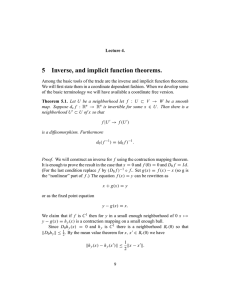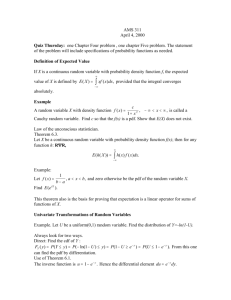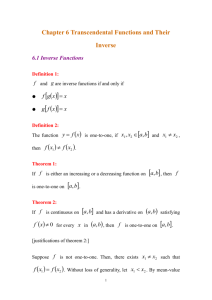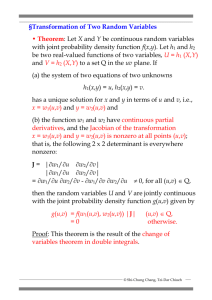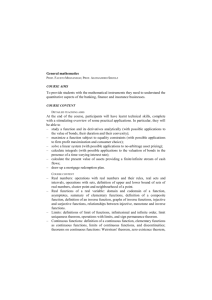Lecture 4. 5 Inverse, and implicit function theorems. Among the
advertisement
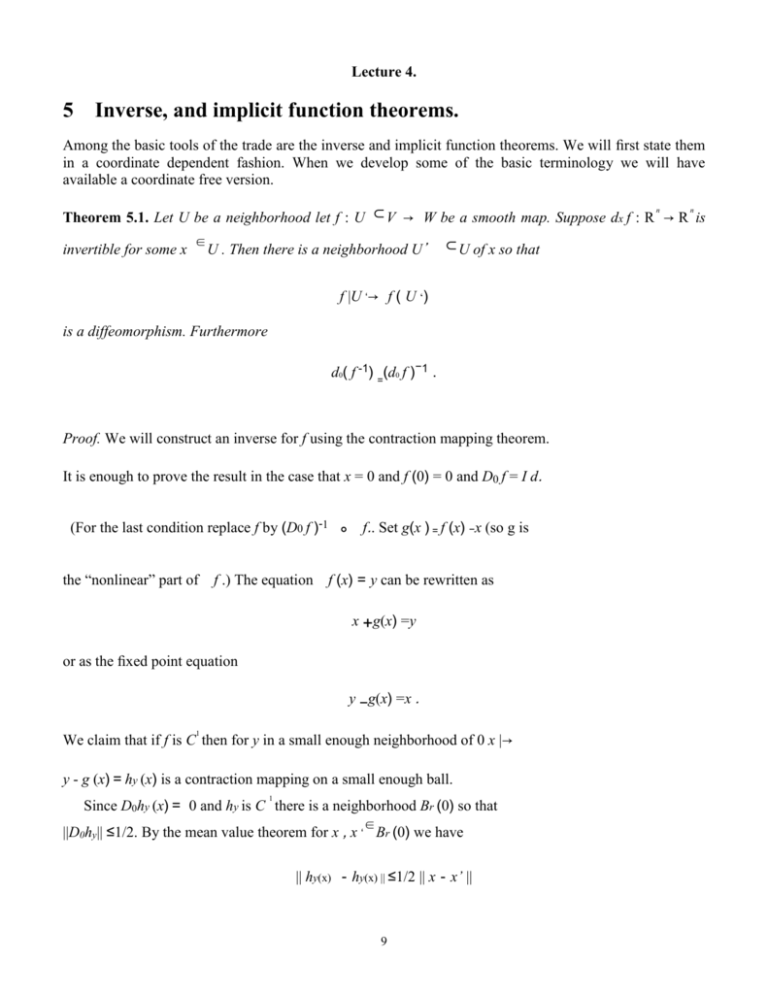
Lecture 4. 5 Inverse, and implicit function theorems. Among the basic tools of the trade are the inverse and implicit function theorems. We will first state them in a coordinate dependent fashion. When we develop some of the basic terminology we will have available a coordinate free version. n n Theorem 5.1. Let U be a neighborhood let f : U ⊂V → W be a smooth map. Suppose dx f : R → R is invertible for some x ∈U . Then there is a neighborhood U’ ⊂U of x so that f |U ‘→ f ( U ‘) is a diffeomorphism. Furthermore d0( f -1) =(d0 f )−1 . Proof. We will construct an inverse for f using the contraction mapping theorem. It is enough to prove the result in the case that x = 0 and f (0) = 0 and D0 f = I d. (For the last condition replace f by (D0 f )-1 the “nonlinear” part of f .) The equation 。 f.. Set g(x ) = f (x) −x (so g is f (x) = y can be rewritten as x +g(x) =y or as the fixed point equation y −g(x) =x . 1 We claim that if f is C then for y in a small enough neighborhood of 0 x |→ y - g (x)=hy (x) is a contraction mapping on a small enough ball. Since D0hy (x)= 0 and hy is C there is a neighborhood Br (0) so that 1 ||D0hy|| ≤1/2. By the mean value theorem for x , x ‘∈Br (0) we have || hy(x) -hy(x) || ≤1/2 || x-x’ || 9 Furthermore if x ∈Br (0) and y ∈Br/ 2(0) we have ||hy (x )|| ≤||hy (x )-hy (0 )||+||hy (0)|| ≤1/2 || x || + || y || ≤r/2 + r/2 ≤r. Thus for y ∈ Br/2 we have hy (Br ) ⊂ Br and hy is a contraction there. The contraction mapping theorem implies for each y the existence of a unique fixed point φ (y) which is a least a set wise inverse for f . We check that φ (y) is continuous. ||φ (y) - φ (y’) || = ||hy (φ (y)) - hy’(φ (y’)) || ≤||g(φ (y)) −g(φ(y’)) || + || y’- y || ≤1/2 ||φ (y) - φ (y’) || + ||y’- y|| so ||φ (y) – φ ( y’) || ≤2 ||y’ – y|| (1) Now we check that φ is differentiable. Let x = φ (y) and x ‘= φ ( y’) ||φ (y) – φ (y’) – (dx f) -1 (y’- y) || = || x – x’ – (dx f) -1( f (x ) – f (x’ )) || -1 -1 ≤||dx f || || (dx f) (x – x’) – ( f (x ) – f (x’ )) || ≤o(||x – x’||) ≤o(||y – y’ ||). where we use the differentiability of f to go from the second to third lines and inequality 1 to go from the third to the fourth. Notice that if f is continuously differentiable then so is φ .An important corollary of the inverse function theorem is the implicit function theorem. The implicit function theorem can be stated in various, each useful in some situation. We will use repeatedly the Open Mapping Theorem which say that a surjective bounded linear map between Banach spaces is an open mapping in particular an bounded linear map which is an algebraic isomorphism is an isomorphism. 10 Theorem 5.2. Let f : U ⊂ V → W be a smooth map with f (0)=0. Suppose that for some x in U we have that Dx f is surjective and ker(Dx f ) admits a closed complement C. Then there are neighborhoods U1 of 0 ∈ker(Dx f ), U2 of 0 ∈W and diffeomorphisms φ : U1 × U2 U2 →W →U and ψ : so that the following diagram commutes: f U → W ↑ φ ↑ ψ U1 p2 U2 U × → 2 where p2 denotes the projection on the second factor. Proof. Write a typical element of U as a pair (k, c) with k ∈ker(Dx f )and c ∈ C . The fact that C is closed means in implies that C is a C a Banach space in its own right. Then the map K × C → V given by (k, c) |→ k + c is an isomorphism by the Open Mapping Theorem. The Open Mapping Theorem also implies that d0,0 f |C :C→ W is an isomorphism. Let L : W → C denote its inverse. Consider the map F (k, c)= (k, L f (k, c)). We have that d0,0 F = Idk * 0 Idc and again by the Open Mapping Theorem the differential of F at (0, 0) is an isomorphism. The inverse function theorem implies F has an inverse, φ, in a neighborhood of (0, 0). Setting ψ = d0,0 f |C we have f (φ (k, c)) = ψ ( p2 (k, c)) on a sufficiently small neighborhood of (0, 0) since L f (φ (k, c)) = c on such a neighborhood. We call a point x where Dx f is not a surjective a critical point. A point in the range of f which is not the image of a critical point is called a regular value. 11 Definition 5.3. A subset Y of a manifold X is called submanifold if for all y ∈Y there is a neighborhood U of Y and a chart φ : V complement. → B so that φ (Y ∩ U ) is an open subset of a closed linear subspace admitting a Having made these definition we have a corollary of the implicit function theorem. Corollary 5.4. The preimage of a regular value is a submanifold. 12

